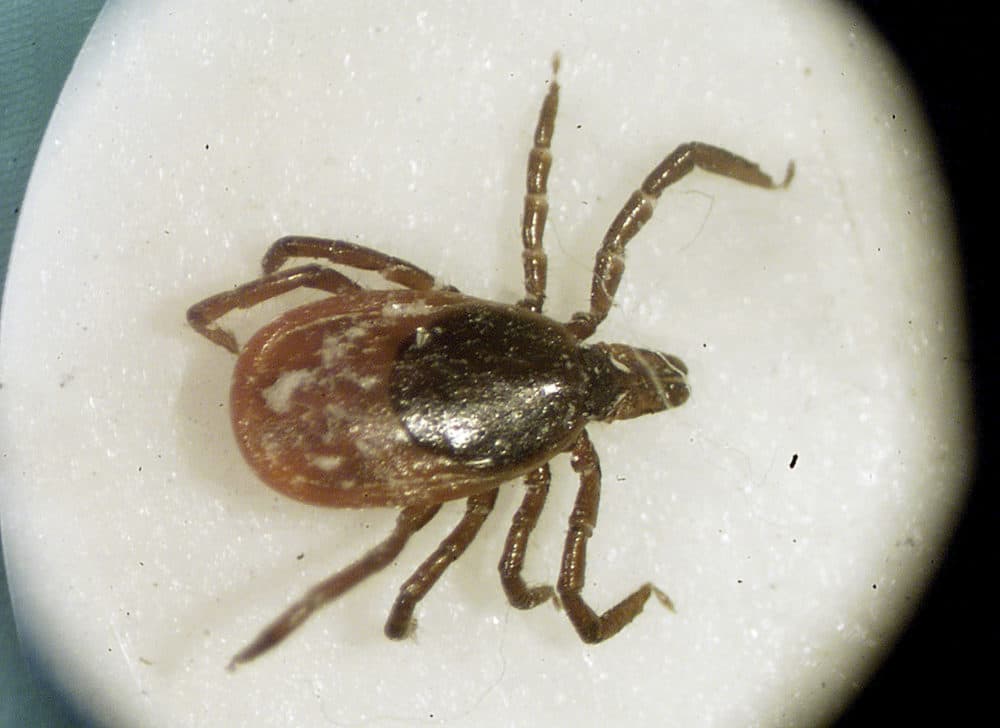Comment; What a great (& effective!) idea. Lace mouse food with an orally effective vaccine against Borrelia so that mice get the vaccine against the agent causing Lyme disease. So far it leads to a 75% reduction in Lyme within ticks on mice–a great start! Let the mouse immune system do the dirty work of killing the bug!

Scattered around a couple dozen homes in Redding, Connecticut, researchers placed black plastic rodent-sized shelters.
“They’re usually used to hold rodenticide for rats,” says Kirby Stafford, an entomologist with the Connecticut Agricultural Experimental Station.
Jan 27, 2020
But for this experiment, each of the structures housed rodent food laced not with poison but with a Lyme disease vaccine – for mice.
About half of ticks infected with Borrelia burgdorferi, the bacterium that causes Lyme disease, get the bug from biting infected white-footed mice. That makes these small woodland critters the most important carriers of the bacteria, Stafford says. If the pathogen could be reduced or eliminated in the mouse population, Stafford believes that could reduce human infections, too.
“So, the idea here is to vaccinate the mice,” Stafford says. “What we’ve done is incorporate a Lyme disease vaccine in an oral bait that would immunize them. That would prevent ticks feeding on those animals from becoming infected and then ultimately turn around and infect you.”
Stafford and his colleagues tested the vaccine for two years by placing the kibble in bait boxes around 21 residential properties.
“We fed it to the mice and captured them. Blood samples were taken, ticks are removed from them, and then the mice are released,” Stafford says.
At the end of the study, Stafford says the kibble vaccine led to a dramatic decrease in Borrelia infections in mice compared to the properties that didn’t get the kibble.
Only about 9 percent of ticks were infected in areas that got the vaccine for two years, but roughly 40 percent of ticks were infected in areas that got nothing, according to the paper.
The researchers report their findings this week in the journal Experimental and Applied Acarology.
With roughly 30,000 to 35,000 cases each year, Lyme disease is the most common illness transmitted by ticks, fleas or mosquitoes in the United States. According to the CDC, Massachusetts is among the states with a high incidence of Lyme disease. Without treatment, Lyme can progress from rashes and joint pain to brain damage, muscle weakness and numbness. In rare cases, some patients continue to experience these symptoms for years.
But aside from personal vigilance and tick checks, there aren’t any proven methods for lowering the Lyme infection rate.
“We’ve got nothing,” says Felicia Keesing, a disease ecologist at Bard College who was not involved in the study. “Nothing that’s been demonstrated to reduce the number of Lyme disease cases in humans.”
The kibble vaccine might have the potential to become a valuable tool in combating Lyme disease, Keesing says. But like many other Lyme prevention methods that scientists have tested, Keesing warns that vaccinating mice may also fail to reduce human cases of Lyme disease.
“It’s a really important problem. One we desperately need to solve,” Keesing says. “We have a variety of things that reduce the number of ticks in people’s yards. Those have not translated to having an effect on people’s health. So this study has the right idea, but it doesn’t mean it will necessarily translate into actually fewer cases in people.”
On top of that, Keesing cautions that flaws in the statistical methods used in the study may have skewed the results.
But Keesing still believes the kibble vaccine shows promise as a method that might help combat Lyme disease.
“I love the spirit of this,” she says. “This has the advantage that a homeowner could put this product in their yard. Other products you need a trained technician.”
And if a kibble vaccine is able to take a bite out of the number of human Lyme disease cases each year, it might provide a low-cost intervention for communities or local governments.
- COVID UPDATE: What is the truth? - 2022-11-08
- Pathologist Speaks Out About COVID Jab Effects - 2022-07-04
- A Massive Spike in Disability is Most Likely Due to a Wave of Vaccine Injuries - 2022-06-30

